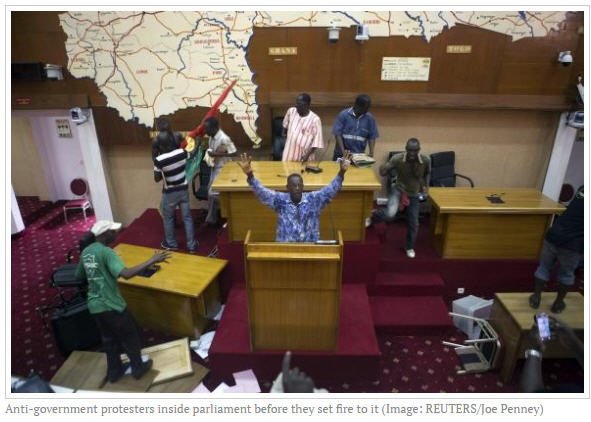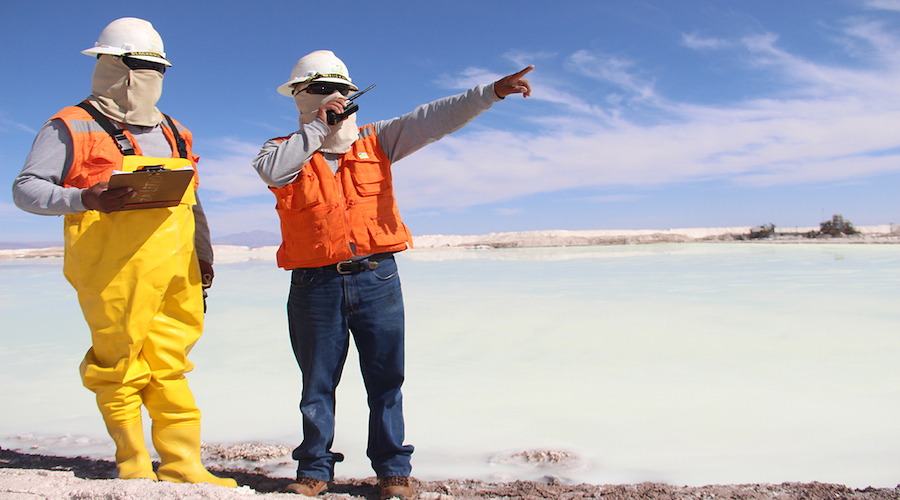What the hell happened to Burkina?
For those that haven’t had access to the internet or TV today, the West African country of Burkina Faso’s government has collapsed and is essentially in complete disarray.
After a day of violent protests, the military seized power and effectively dissolved the country’s parliament.
This is a surprise, coming out of one of the more stable countries in West Africa and one that has avoided brutal decade-long civil wars like the ones seen in neighboring Sierra Leone and Liberia.
Protests erupted after long-time President Blaise Compaore proposed they have a national assembly to vote on whether to allow him to run for a fifth 5-year presidential term. Protestors stormed the parliament building and set fire to the main chamber in disapproval, and the vote never took place.
On Thursday evening, only a few hours after the President declared a state-of-emergency and called for an end to the protests, the Burkina Faso military staged an apparent coup d’état and announced the dissolution of the government.
In a press conference, General Honoré Traoré, said that a “transitional body” would be set up in the interim before a return to the constitutional order within a year.
Since then, the President has declared he will maintain power over the next year in transition. However, the opposition and protesters want him gone now.
Beyond the obvious and immediate troubles this causes for the region, a large component of their economic future, mining, is under threat as well.
A whole slew of companies came out with news releases throughout the day today which said something along the lines of:
“Company X has provided the following update regarding the civil unrest in Burkina Faso. The company’s operations at the X project, located approximately X kilometres from the capital of Ouagadougou, are uninterrupted, on-site work continues, and all of its employees are accounted for and safe. Company X will provide further updates as events warrant.”
Although these releases are probably true, the reality is that this apparent coup d’état is so new that no one in the region knows what effect (lasting or not) it will have on the mining sector.
With investors already running for the exits and no risk appetite to be found anywhere, this could cause even further price declines for companies with exposure to the country.
There are a number of public mining companies with significant exposure (>33% of assets) to Burkina Faso, including many single asset developers. These include:
- SEMAFO (SMF:TSX) – Mana mine located 350km west of the capital of Ouagadougou and is set to produce 200-220koz of gold in 2014 (100% of the company’s production)
- True Gold Mining (TGM:TSXV) – Karma development project which is now funded and is well into construction (100% of the company’s assets). Located 185km northwest of Ouagadougou.
- Roxgold (ROG:TSX) – Yaramoko is one of the highest grade undeveloped gold deposits in the world and is about to start construction. They are working on finalizing loan documentation on a $75 million facility package which could present problems if the lenders get scared. (100% of the company’s assets). Located roughly 200km southwest of Ouagadougou.
- Orezone (ORE:TSX) – Bombore development project is located 100km southeast of Ouagadougou. It is moving forward with a few studies, but has been fairly inactive recently so there should be less impact here. Bombore represents essentially all of Orezone’s value.
- Nordgold (NORD:LSE) – Bissa gold mine is located approximately 85km north of Ouagadougou. The company also operates the Taparko mine located 200km northeast of Ouagadougou. Combined, the two projects account for almost 40% of the company’s revenues.
Others with more diversified portfolios but that still have exposure to Burkina Faso include:
- IAMGOLD (IMG:TSX) – Essakane gold mine accounts for roughly 1/3rd of IAMGOLD’s annual production. The mine is located 330km northeast of the capital of Ouagadougou. IAMGOLD recently sold its Niobec niobium mine in Quebec to Aaron Regent’s Magris Resources reducing the company’s diversification.
- Endeavour Mining (EDV:TSX) – currently the company only has one mine, Youga that is in operation in Burkina Faso. Youga accounts for less than 25% of their gold production. However, the company’s growth is linked to the Hounde development project which is projected to add 180,000 ounces of gold annually to Endeavour’s 400,000 ounce per year profile (45% increase). This could have a material impact on the stock should instability spread and last.
- B2Gold (BTO:TSX) – Kiaka was acquired when B2Gold bought Volta in 2013 for $63 million. The project is large and has the potential to add 340,000 ounces to B2Gold’s production profile, but it has been on the back burner since it was acquired as the project likely requires higher gold prices to justify the capex requirement.
- Glencore (GLEN:LSE) – Perkoa zinc mine is located 120km away Ouagadougo and is the first large scale base metal mine in the country. It’s estimated to produce 90,000 tonnes of contained metal over a 12 year mine-life. This is a small portion of Glencore’s global operations.
Burkina remains a critical ally for the US and France in the region and the country has been proactive in the fight against Muslim extremists within its borders. France was set to send in more troops to assist in the coalition against extremists in the area.
The country has been a relatively stable part of West Africa and we hope peace is restored soon so that average Burkinian’s can return to their daily lives.
Here’s video courtesy of BBC News of what occurred today:
{{ commodity.name }}
{{ post.title }}
{{ post.date }}






2 Comments
ChiSpy
This just re-emphasizes the following truism that all investors should keep in the forefront of their analyses: there is political risk in all jurisdictions – it’s just a matter of degree.
Ivan Fed
The “experts” said that country was one of the most stable countries in Africa.Well that speaks alot for the continent.I guess USA will send in troops looking for more Ebola cases. Keep our troops at home and improve our economy.